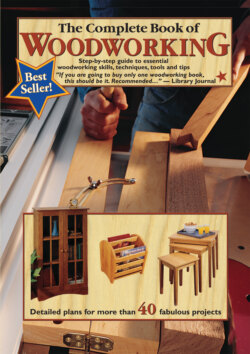Читать книгу Draw Manga - Tom Carpenter - Страница 29
На сайте Литреса книга снята с продажи.
Buying basics
ОглавлениеWhether you buy from a chain store, specialty or contractor’s yard or by mail, keep a few basic rules of thumb in mind when shopping for project lumber:
1. Develop a realistic shopping list. Base your list on a clear understanding of common lumber proportions and grades (See here to here for more on common lumber sizes and grades). Make a preliminary visit to your lumberyard, acquire a catalog, or call the city desk before leaving home to verify that the dimensions and species you need are available. Know ahead of time what compromises you can make to your cutting and shopping lists, if what you need isn’t available in the right size or species.
2. Consider using less-expensive woods like poplar or pine in hidden areas of your project. Woodworkers have used “secondary” woods for centuries in fine furniture and cabinetry, saving premium lumber for prominent project parts like face frames, doors, drawer fronts and tabletops. Don’t underestimate the versatility, economy and structural benefits of using sheet goods like plywood and particleboard over solid wood (See here to here).
3. Factor in about 30% waste. As you become more practiced in estimating, you’ll be able to reduce this percentage somewhat. If you are just getting started as a woodworker, buy more lumber than what you’ll need for a project. Save your receipt and return what you don’t use. Published plans occasionally have errors in shopping and cutting lists that will require you to have more material on hand. If you buy lumber roughsawn, you may not discover an unsightly blemish or pitch pocket until after you plane it, resulting in less usable lumber than you initially planned. And be honest about your own “fudge factor.” One miscalculated cut late on a Saturday afternoon might put an end to your woodworking for the weekend if your lumberyard isn’t open on Sundays.
4. Comparison shop before you buy. Once you are sure of your project requirements, check how the prices vary among suppliers. Yards may offer discounts on slightly damaged lumber or overstocks, especially at inventory time.
5. Plan for how you’ll safely transport large materials home, especially sheet goods. If the yard offers delivery, take advantage of the service especially if your only other option is to tie several unwieldly sheets of plywood to the roof of the family sedan. Some yards will cut your lumber into more manageable proportions for free, or for a modest charge. If you go this route, double-check your cutting list so you can decide ahead of time what can be sized down without compromising your project needs.
Plywood is manufactured in several thicknesses, using a variety of wood species to create the core, but ¾-in.-thick laminated veneer-core plywood with smooth hardwood veneer faces is the type used most frequently for built-in projects.
Medium-density fiberboard (MDF) is growing in popularity as a veneer substrate, paintable surface, and as a raw material for moldings.
Particleboard is used almost exclusively as a substrate for plastic laminate or veneer, especially for countertops. It is inexpensive but lacks sufficient strength to be used for shelving or structural members.
Melamine is faced at the factory with melamine laminate. The thermofusing process used to apply the melamine creates a much stronger bond than you can achieve by applying plastic laminate yourself.
